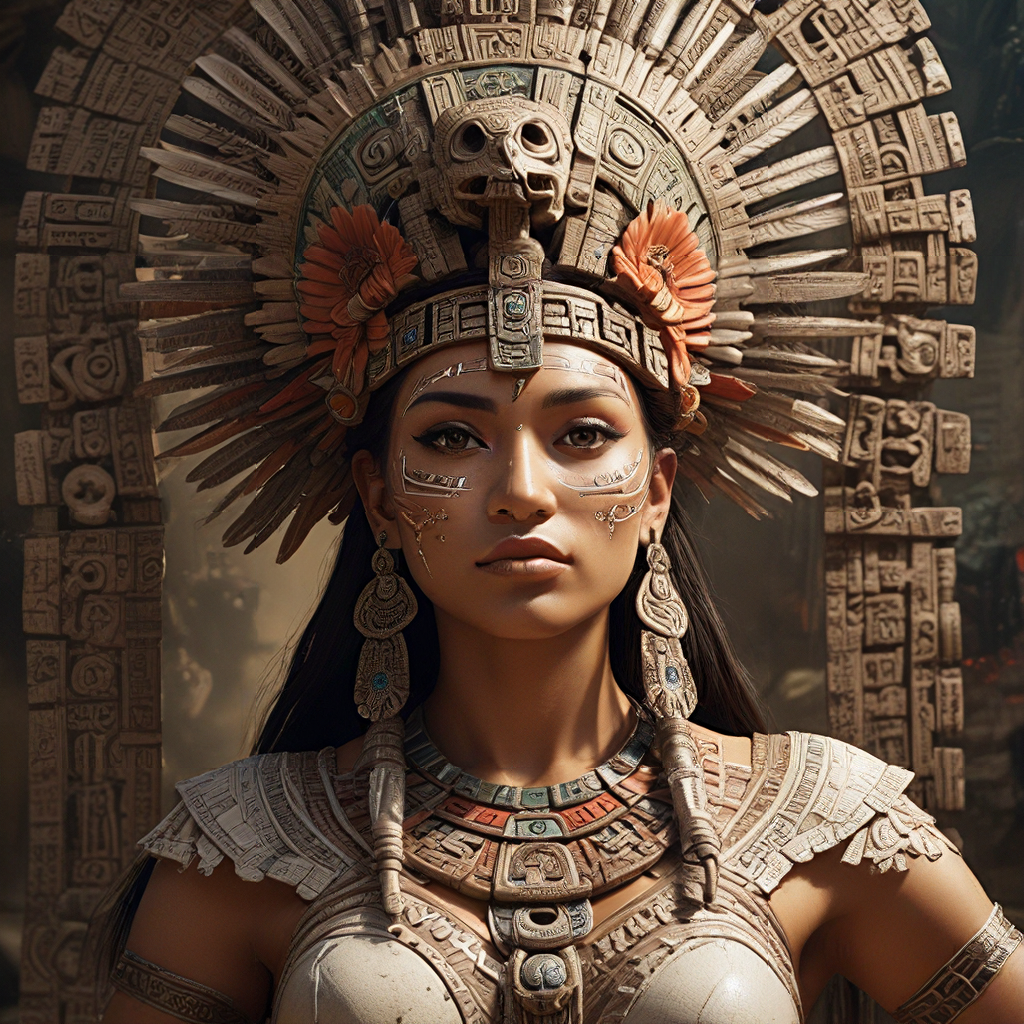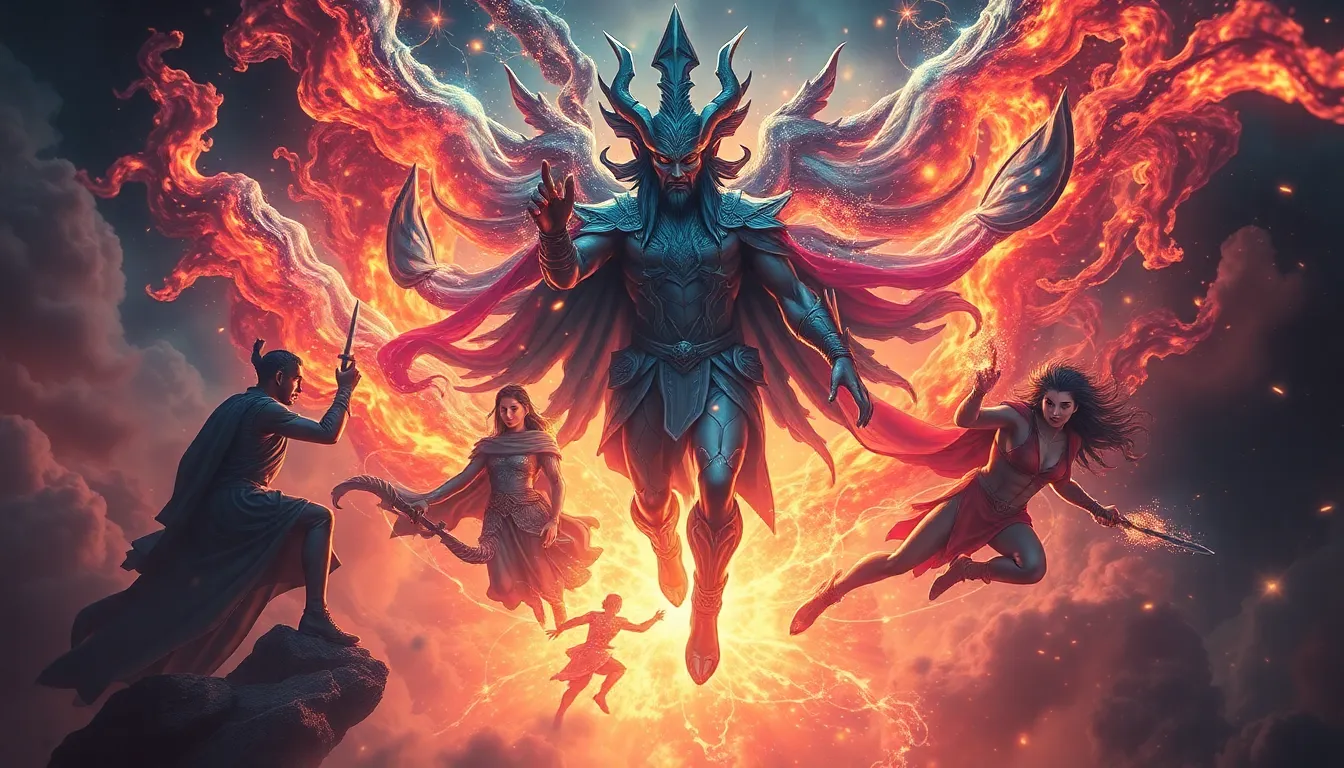The Birth of Tlaltecuhtli: From Chaos to Creation
In the beginning, before the world as we know it existed, there was only a vast, swirling abyss of chaos. From this chaos, emerged the primordial goddess, Tlaltecuhtli, the Earth Goddess of the Aztecs. Her name, meaning “Earth Eater,” hints at her powerful connection to the earth and its vital forces. The Aztecs believed that Tlaltecuhtli was born from the primordial waters, representing the very essence of creation. She was a being of immense power, her body forming the foundation of the world, and her essence animating it. This origin story underscores the unique role of Tlaltecuhtli in Aztec mythology: she represents the very beginning of existence, the point from which all things sprang.
The Primal Mother: Tlaltecuhtli as the Foundation of the World
Tlaltecuhtli, often referred to as the “Earth Mother,” served as the foundation and bedrock of the Aztec world. Her massive body, a sprawling canvas of earth, mountains, and oceans, supported the heavens above and the underworld below. She was not only the physical foundation of the world but also its energetic source. The very life force of the earth, its ability to sustain plants and animals, flowed from her heart. In many ways, Tlaltecuhtli embodied the complex and dynamic relationship between the earth and its inhabitants.
Her Form: The Terrifying and Majestic Form of Tlaltecuhtli
The Aztec depictions of Tlaltecuhtli are as striking as they are terrifying. She is often shown as a monstrous creature, a hybrid of animal and human forms. Her body is adorned with a mix of human, animal, and plant features, reflecting her role as the source of all life and death. Her mouth is often depicted as gaping wide, revealing rows of sharp teeth, symbolizing the earth’s destructive power. Despite the fearsome nature of her appearance, she is also depicted as a majestic being, her powerful form commanding respect and awe. Her representation is a reminder that the earth, while a source of life and sustenance, also possesses a destructive power.
Tlaltecuhtli’s Role in Aztec Cosmology: The Earth, Mountains and the Underworld
Within the Aztec cosmology, Tlaltecuhtli plays a vital role in connecting the different realms. Her massive body formed the earth, while her limbs stretched out to form the mountains. The underworld, Mictlan, was also located within her body, reflecting the cyclical nature of life and death. The Aztecs believed that souls journeyed to the underworld after death, passing through Tlaltecuhtli’s body on their way to their final destination. Their belief reflected a deep understanding of the interconnectedness of life, death, and the earth.
The Sacrifice of Tlaltecuhtli: A Necessary Act for Creation
According to Aztec mythology, the creation of the world required a significant sacrifice. The gods, realizing that Tlaltecuhtli’s immense power was too much to control, decided to sacrifice her. This act, while seemingly brutal, was necessary for the creation of the world as we know it. By sacrificing Tlaltecuhtli, the gods transformed her body into the earth, mountains, and oceans, bringing light and order to the previously chaotic world. This sacrifice embodies the Aztec understanding of death as a necessary component of creation, a vital cycle that ensures the continued existence of the world.
Tlaltecuhtli’s Connection to Fertility and Agriculture: Providing Life from the Earth
The sacrifice of Tlaltecuhtli not only gave birth to the world but also imbued the earth with the power of fertility. Her essence, now woven into the very fabric of the earth, ensured the growth of crops and the birth of new life. For the Aztecs, agriculture was not just a way of life; it was a sacred practice, a direct connection to the Earth Goddess. They understood that every harvest, every birth, was a gift from Tlaltecuhtli, a reflection of her life-giving power. Farmers, therefore, held a special place in Aztec society, acting as intermediaries between the human world and the divine. They were tasked with coaxing life from the earth, respecting its cycles, and offering gratitude for its bounty.
Tlaltecuhtli and the Aztec Rituals: Offerings and Sacrifices to the Earth Goddess
The Aztecs paid homage to Tlaltecuhtli through various rituals and offerings, demonstrating their deep respect and dependence on her power. They believed that maintaining a good relationship with the Earth Goddess was essential for ensuring a bountiful harvest and a prosperous life. Rituals often involved offerings of food, flowers, and precious objects, placed on the earth as a sign of gratitude.
However, the most significant offerings to Tlaltecuhtli were human sacrifices. The Aztecs believed that the blood of humans was a powerful offering that could appease the earth and ensure her continued favor. These sacrifices were not merely acts of cruelty, but rather symbolic acts of devotion, representing the cycle of life and death, and the interconnectedness of humans and the earth.
Tlaltecuhtli in Aztec Art: Depictions in Sculpture, Paintings, and Codices
The awe-inspiring presence of Tlaltecuhtli is evident in Aztec art, where she is often depicted in powerful and intricate sculptures, paintings, and codices. The most famous representation of Tlaltecuhtli is the monolithic stone sculpture found at the Templo Mayor in Mexico City. This colossal figure, featuring a gaping maw, ferocious claws, and a serpentine body, embodies the powerful and fearsome nature of the Earth Goddess. Her image also appears in numerous murals, paintings, and codices, often depicting her surrounded by symbols of life and fertility, such as plants, animals, and human figures. These depictions not only served as a visual reminder of Tlaltecuhtli’s power but also helped to reinforce her role as the source of life and the sustainer of the world.
Interpretations of Tlaltecuhtli: A Symbol of Power, Creation, and the Cycle of Life and Death
Tlaltecuhtli, the Earth Goddess, is a complex and multifaceted figure in Aztec mythology. She embodies not only the power of creation but also the cycle of life and death. Her terrifying appearance is a reminder of the earth’s destructive power, while her nurturing nature symbolizes her ability to sustain life. Her image is a powerful reminder of the interconnectedness of humans with the earth, highlighting the importance of respecting nature’s cycles and recognizing the delicate balance between life and death. Tlaltecuhtli’s influence extends beyond the realm of Aztec mythology, offering insights into human perceptions of the earth, its power, and its vital role in sustaining life.
The Enduring Legacy of Tlaltecuhtli: Influence on Aztec Culture and Beyond
The legacy of Tlaltecuhtli continues to resonate in modern times, her image is a powerful reminder of the ancient Aztec culture and its deep connection to the earth. Her story continues to capture the imagination of artists, writers, and scholars, inspiring new interpretations of her power and significance. Tlaltecuhtli, as a powerful embodiment of the earth’s creative and destructive forces, serves as a symbol of the interconnectedness of all things and the importance of respecting the delicate balance of nature.
FAQ:
Q: What is the significance of Tlaltecuhtli’s name?
A: Tlaltecuhtli's name, meaning “Earth Eater,” highlights her powerful connection to the earth and its vital forces. It also hints at her ability to both nourish and destroy.
Q: What are some of the key features of Tlaltecuhtli's appearance?
A: Tlaltecuhtli is often depicted as a monstrous creature with a mix of human, animal, and plant features. She has a gaping maw with rows of sharp teeth, claws, and a serpentine body. Her appearance is a reminder of the earth’s destructive power.
Q: What was the purpose of human sacrifices to Tlaltecuhtli?
A: The Aztecs believed that human sacrifices were essential to appease the Earth Goddess and ensure her continued favor. They considered the blood of humans to be a powerful offering that could sustain the earth’s fertility.
Q: How does Tlaltecuhtli’s story connect to the idea of the interconnectedness of life and death?
A: Tlaltecuhtli’s story highlights the cycle of life and death, emphasizing that death is a necessary component of creation. Her sacrifice gave birth to the world, and her body continues to nourish and sustain life.
Q: What is the modern-day relevance of Tlaltecuhtli?
A: Tlaltecuhtli’s story serves as a reminder of the ancient Aztec culture and its deep connection to the earth. Her story inspires new interpretations of the earth’s power and the importance of respecting nature’s cycles.



